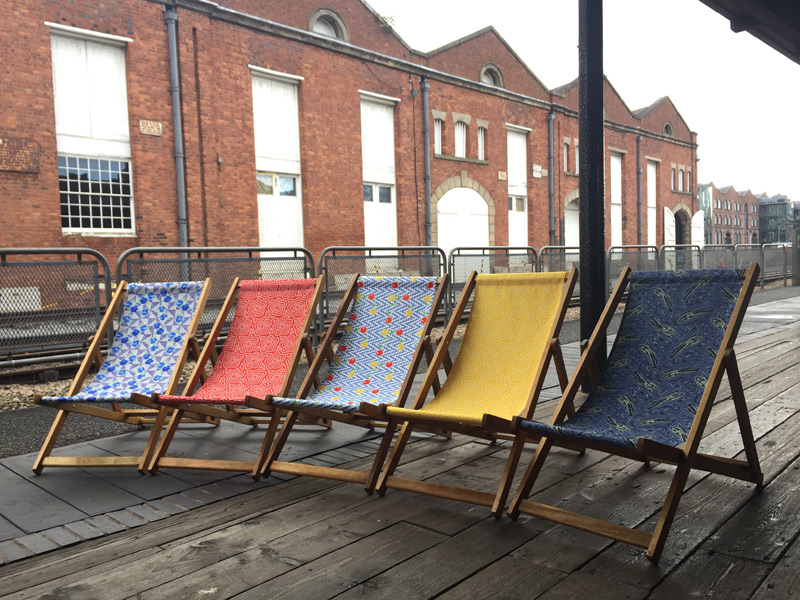Manchester might have a bit of a reputation for wet weather, but when the sun shines it really is glorious here. At the Museum of Science and Industry, we’re lucky to have a sizeable outdoor space, and there’s a brand-new picnic area now to enable visitors to better enjoy it.
As well as a suite of lovely red picnic benches, when the weather’s good you’ll notice some inviting deckchairs with eye-catching repeating designs. What you might not realise is that these patterns are drawn from archives relating to Manchester’s textile design history, held here in the museum. As Manchester was such an important centre for the cotton industry—a story told in the museum’s Textile Gallery—there was a demand for good quality design, which led to many important design studios becoming established in the area. Textile designers produced patterns for printed fabrics, which were used in clothing and furniture items; perfect for a deckchair sling.

Most design studios used the continental method of producing a croquis, or initial sketch. This was drawn complete, but not in repeat for the printer, meaning it was possible to draw the design quickly. I spent a great morning in the Collections Centre here at the museum looking through boxes of hand-drawn and painted design sketches. We were searching for patterns that would repeat nicely over a stretch of fabric, and that used bright, primary colours to bring the yard to life.
One designer that immediately popped out was Randall Paine, with his bold, colourful designs, which he created to a mathematical formula to produce a pattern repeat to fit the printing rollers. Paine was born in Failsworth, and on leaving school worked for textile designer John Brewer, later becoming a partner in Brewer & Paine. The museum archive holds an extensive collection of textile print designs produced by Brewer & Paine between 1925 and 1939. The partnership lasted until the outbreak of the Second World War, when colour printing ceased in favour of military clothing.

Science Museum Group © The Board of Trustees of the Science Museum
Harry Rodwell Prince’s concentric floral pattern was a favourite too. Prince began his career as a trainee designer with Headon Designs of Faulkner Street, Manchester, in 1928. He opened his own design studio in 1935, producing designs for shirts until the outbreak of the Second World War similarly curtailed business. He later worked for the famous menswear company Moss Bros along with his wife Evelyn.
Finally, the cheery repeating aeroplanes of Jacob Dimoldenberg seemed a perfect fit for the museum. Dimoldenberg had a fascinating life—born in Thessaloniki, Greece, he grew up in the Jewish quarter of Paris and was granted French citizenship after fighting in the Foreign Legion in the First World War, until he was wounded at the battle of the Somme. Dimoldenberg trained in print design and began his career in Paris, before marrying and moving to the Cheetham Hill area of Manchester in 1919. He designed fabric for ties, shirts, scarves and women’s clothing, and also produced African inspired designs in the 1920s and 1930s.
The repeating and recolouring of croquis was one of the most difficult parts of the design for studios, requiring a lot of skill and experience. After the chosen designs were scanned in by one of the museum archivists, we worked with a graphic designer to repeat them for the deckchairs and to clean them up digitally; as they come from original drawings, pencil lines and the odd fingerprint were visible.
If you’re interested in finding out more about the textiles archives at the museum, you can find a wealth of information in our online archive. You can also visit the collections study area by appointment for personal, professional and academic research. Contact collections@scienceandindustrymuseum.org.uk for further information about accessing the archives.
Now we’re just keeping everything crossed in hope that the weather behaves itself…
Fantastic to see one of my grandfather’s designs being used in this way. He would have been delighted, as would have my father. Thank you!